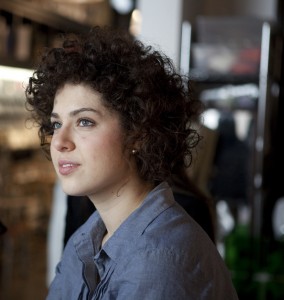Armenian Genocide Memorial: Design in the Public Space for Reflection and Remembrance
- Social Entrepreneurship
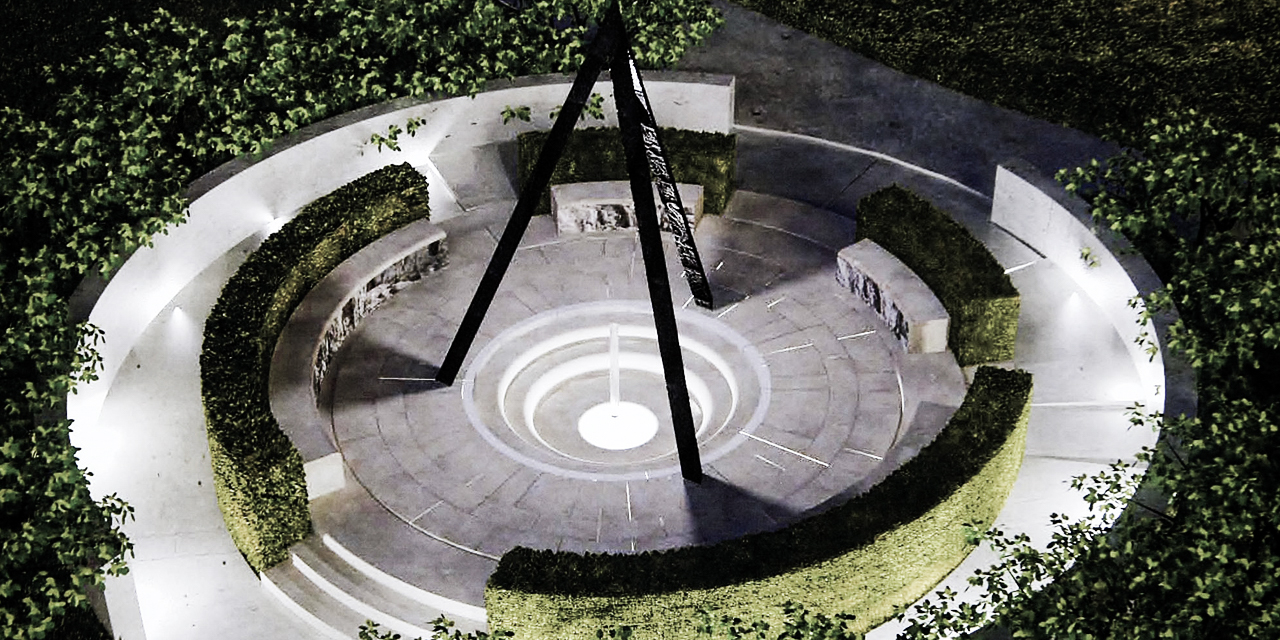
In the fall of 2012, ArtCenter students responded to a public RFP issued by the City of Pasadena to submit proposals for the architectural design and construction of an Armenian Genocide Memorial to be erected in Pasadena’s Memorial Park.
We were deeply impressed by Catherine, who developed and presented an emotionally compelling design for a historical event that she initially knew nothing about. We hope that this memorial will inspire a similar emotional connection in those who encounter it, for generations to come.
– William M. Paparian, Esq., Chair, Pasadena Armenian Genocide Memorial Committee (PASAGMC) and former Mayor of Pasadena”
Recent Project Developments

Memorial Unveiling
On April 18, 2015, over 1500 people were on hand to witness the unveiling of the Armenian Genocide Memorial at Pasadena’s Memorial park. Pasadena Mayor, Bill Bogaard spoke at the ceremony as well as the monument’s designer, Art Center Alumna, Catherine Menard. The memorial consists of a metal tripod standing 16 feet tall. From the top of the tripod, a drop of water falls every 21 seconds. Each year, 1.5 million drops of water — one for each of the genocide victims — will drop into a basin adorned with the ancient Armenian symbol for eternity.
My hope is that it will be significantly important to the Armenian community and eye opening and moving to the unaware passer-by.
– Catherine Menard, Armenian Genocide Memorial Designer, Art Center Alumna
Ground Breaking Ceremony
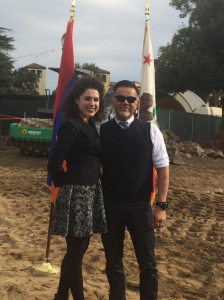 The ground breaking ceremony for the Pasadena Armenian Genocide Memorial took place on January 25, 2015 at Memorial Park. The memorial’s designer, Catherine Menard was in attendance along with Art Center faculty James Meraz, Pasadena Armenian Genocide Committee board members, city officials, and representatives from area Armenian churches and schools. The Memorial is scheduled for completion on April 18. 2015, ahead of the 100th anniversary of the Armenian Genocide on April 24.
The ground breaking ceremony for the Pasadena Armenian Genocide Memorial took place on January 25, 2015 at Memorial Park. The memorial’s designer, Catherine Menard was in attendance along with Art Center faculty James Meraz, Pasadena Armenian Genocide Committee board members, city officials, and representatives from area Armenian churches and schools. The Memorial is scheduled for completion on April 18. 2015, ahead of the 100th anniversary of the Armenian Genocide on April 24.
Project Background
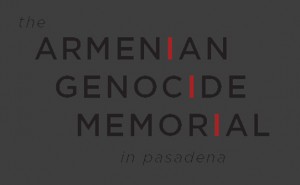
The Armenian Genocide was the systematic extermination of the Armenian population from its historic homeland by the Ottoman government. It took place during and after World War I. The total number of lives destroyed as a result has been estimated at between 1 and 1.5 million.
Although Los Angeles has the greatest population of those of Armenian descent outside of Armenia, no memorial or recognition exists in Glendale, Pasadena, or Hollywood of the event known as the first modern genocide.
Design Brief
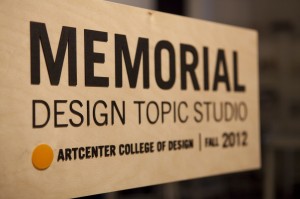
The Armenian Genocide Memorial project called for the design and construction of a public space in reflection and remembrance of the Armenian Genocide. The memorial is to be erected in the Pasadena Memorial Park, previously known as the Library Park, located at 85 E. Holly Street, at the south-east corner of Raymond Avenue and Walnut Street in the City of Pasadena.
Students were challenged with designing a public space that was not only culturally relevant but also took into consideration: interactivity, public design restraints, hardscape/landscape, public safety, possible inclement weather conditions and of course social impact. Art Center students, worked individually or in groups of two to come up with designs that addressed the aforementioned criteria while also inspiring peaceful reflection and a visceral, emotional response.
Research and Project Development
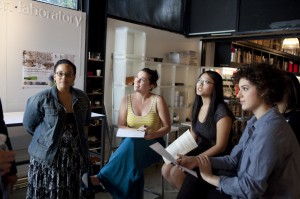
The Art Center team, led by Environmental Design faculty James Meraz engaged in a compressed 7 week studio process–an abbreviated timeline compared the College’s normal 14-week term– to comply with the RFP submission deadline. During that time, they took in a plethora of research around the theoretical framework of case studies employing unconventional design processes. During class discussions, the students debated the relevance of these theoretical frameworks and were encouraged to keep a “think tank” environment in class to help inspire deep and thoughtful work. It was mandatory that the students also keep a notebook/sketchbook to record all of their notes, matricies, case studies, and ideation possibilities, as well as collage works, thumbnails, and other journal items.
The research and class discussions proved to be extremely helpful in informing the student’s design strategies. They found that with the Armenian Genocide Memorial Project, researching the psychology of the interaction between man, landscape and space was a very important part of crafting a strong design proposal and that they had to pay close attention to the psycho-emotional impact their designs could potentially inspire.
Outcomes
The students presented their design proposals to members of the Pasadena Armenian Genocide Memorial Committee (PASAGMC) and other distinguished guests during the class final. Afterwards, they were given feedback and time to make adjustments to their design proposals for final submission to the City’s RFP. Art Center student designs were submitted alongside artists and designers from around the world and were the only students considered for this project. Of the 17 submitted designs, 3 were chosen for final presentation to the (PASAGMC). Two of these were designs of Art Center Environmental Design students Catherine Menard and JD Clark. The final design proposal the committee selected for realization belongs to Catherine Menard.
Below are statements that Catherine presented to the Committee about her design.
I’ve approached this project with caution, reverence and longing to conjure a meaningful emotional experience.
– Catherine Menard, Student, Environmental Design
I’ve learned through this journey that this genocide has not been acknowledged and that an urgent need for understanding is necessary to begin to heal the hearts of the Armenian people and reclaim the land lost. I absorbed the archived documentation of murder and terror to these innocent and helpless generations. This is the proof of these crimes.
The memorial form is an abstraction of this proof. This reality must be understood in order for the new generation to hear these cries. This devastation is not what remains however. For underneath the pinnacle of the structure is the slow‑paced descent of the baptized and pure, innocent trail of spirits. The weight of the 1.5 million sends the basin to set deeply into the ground where the words of their story emerged from below. The ability the engage with the water passage on the exterior of the beams is very integral in the convergence of horror and hope.
The structure is not to the scale of the individual, it is as monumental as the death it embodies. This is a sacred space, with ancient sign in hope of passing understanding into the future of Armenian heritage.
– Catherine Menard, Student, Environmental Design
Although it is a very daunting structure; a very strong and horrific form that I feel that most of us understand and remember and recognize upon first glimpse the juxtaposition of that healing at the very center point hopefully balances out that understanding. So, you’re warned from the beginning that you’re about to enter something very deep and intense and possibly scary.
You must encounter this fear to understand what has happened. So, that the inscription in the center point as you ascend all the way up into the structure remarks on the innocent lives that were marched, tortured, and publicly executed along for those years till 1923.
Project Publicity
- Subtle Commemoration: Pasadena’s Armenian Genocide Memorial (KCET, April 2015)
- Large Crowd Gathers for Unveiling of Poignant Pasadena Armenian Genocide Memorial (PNN, April 2015)
- Pasadena Armenian Genocide Memorial a Powerful Tribute to Victims (PSN, April 2015)
- Ground Broken on Pasadena Armenian Genocide Memorial (PSN, Jan. 2015)
- Pasadena City Council Approves Armenian Genocide Monument (LA Times, Sept. 2013)
- Hallowed Ground (Pasadena Weekly, April 2013)
- Tears of a Nation (Feb. 2013)
